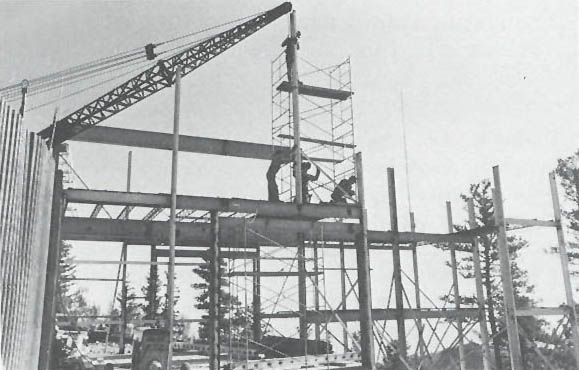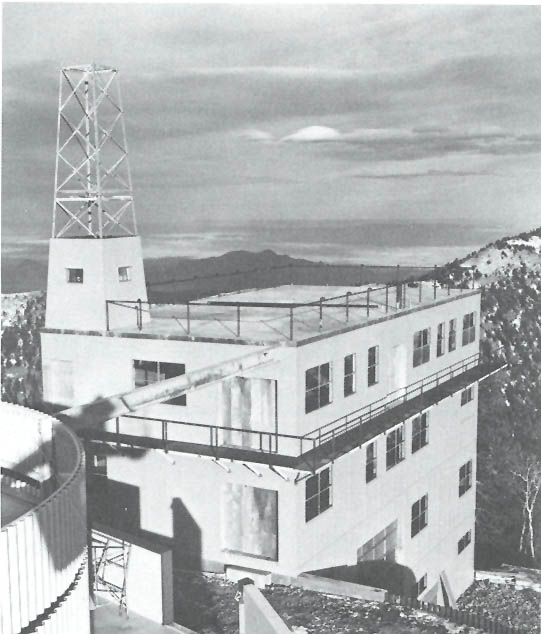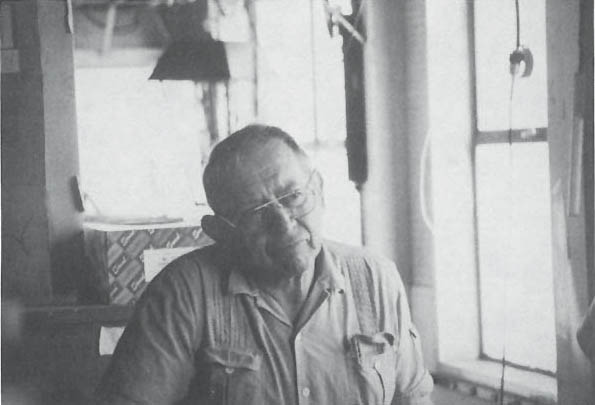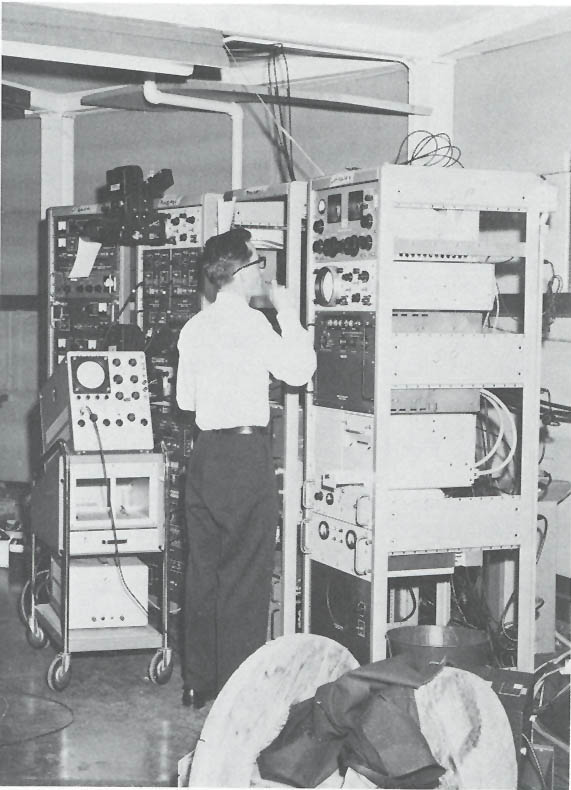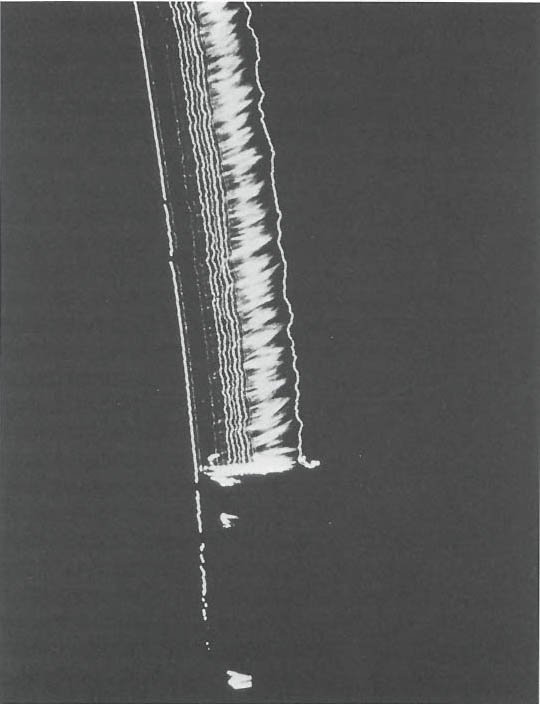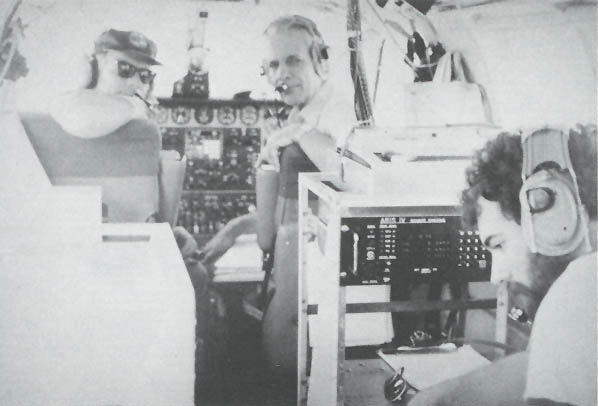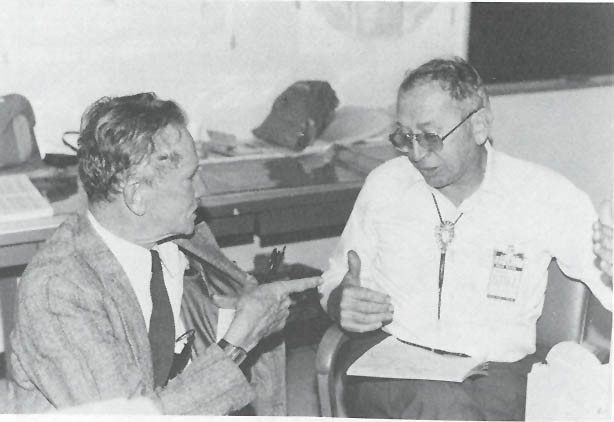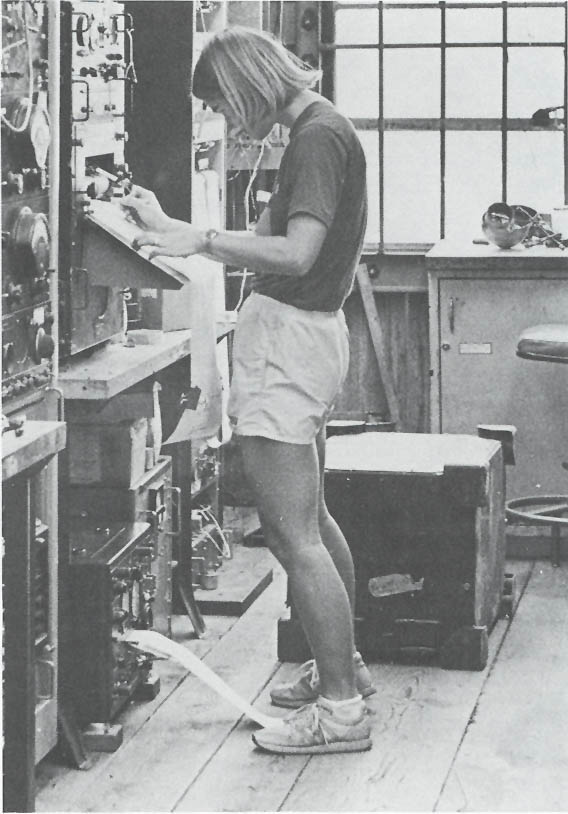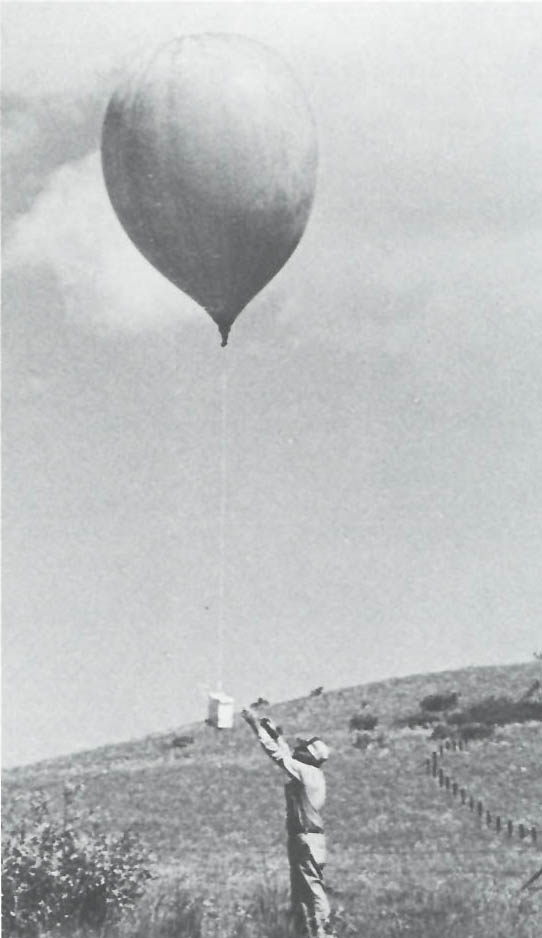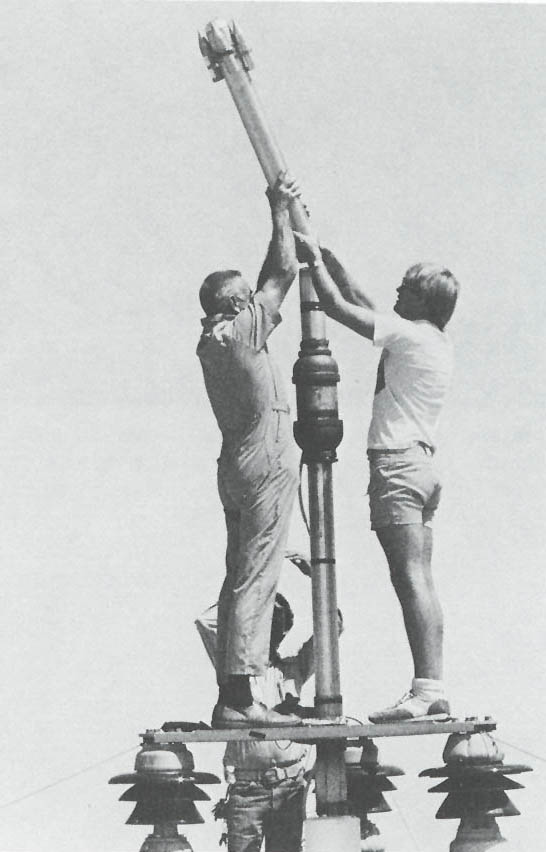7
The Dream Thunderstorm
During the late sixties and early seventies, several new atmospheric researchers joined the New Mexico Tech staff and began to make important contributions to the Research. Among them were Bill Winn, an atmospheric physicist, and Paul Krehbiel, an electrical engineer.
Winn arrived in 1970, just after the facilities and activities at Langmuir began to grow in earnest. His primary work was to be the study of cloud electrification with airborne instruments; one of his first contributions was the use of instrumented rockets for probing thunderstorms. A variety of rockets have been used over the years at Langmuir, but Winn's favorites were military-surplus 2.75-inch attack rockets. In Vietnam, these rockets were carried by helicopter gunships for use against enemy troops. Winn put them to a more peaceful use, replacing their explosive warheads with electric-field meters and radio telemetry circuits. When the storm overhead grew interesting, Winn would push the button. The rocket would shriek off at supersonic speeds, penetrating the cloud and sending back data.
Although their warheads had been removed, these rockets were still dangerous. They were two feet long and fairly heavy, and they went off like--well, like rockets. Restricted Airspace R5 113, the only restricted airspace ever set up for civilian research, was established over the lab area in 1971 at the request of Winn and Moore. That took care of the danger of shooting down stray private pilots.
|
|
||||
|
The Annex under construction.
|
The Annex just after
completion. |
||||
|
|
|
Marx Brook on a visit to the lab in
1986. |
Krehbiel, as an electronics engineer, was not involved in hypothesizing so much as in designing instruments to gather data. One of his most important contributions to the research effort was the Fast Scanning Cloud Physics Radar, which Marx Brook and he invented, the unit, patented in 1975, was soon nicknamed the Redball Radar because of the spinning red ball that housed its antenna. It transmits broadband radio-frequency "noise" in order to explore various aspects of a cloud's structure rapidly. Mounted on a semi trailer, the Redball Radar has been towed up to South Baldy for several summers. It is getting old, at least by electronic standards, and its ball is now white rather than red, but it continues to provide useful results.
In the mid-seventies came a pair of aircraft, both powered sailplanes, for the lab's use. One of them, equipped with an exceptionally powerful engine and designed for high-altitude flight, was assembled specifically for use at Langmuir out of parts from various sources. The plane has "NOAA" (for National Oceanic and Atmospheric Administration) painted on the fuselage and "Air Force" painted on the wing. The fuselage used to read "Navy." The plane's mixed parentage is evident only to people who go to the Socorro airport and look inside the Tech hangar, for it has not flown in several years. It needs a new engine, which will be purchased and installed as soon as someone comes up with an extra $70,000 or so.
The other plane, SPTVAR I, has been more useful. The Special Purpose Test Vehicle for Atmospheric Research is a powered Schweizer sailplane that began its career as a reconnaissance drone in Vietnam. After the war it went to the Office of Naval Research (ONR), where the remote-control equipment was removed and a rather cramped space for a pilot was carved out. Reinforcements were added to permit relatively safe flights through active thunderstorms. In 1975 the ONR provided the plane to Tech on a long-term loan. It became the domain of veteran research pilot Bill Bullock, formerly chief pilot for the National Center for Atmospheric Research. Bullock now runs Air, Inc., in Colorado Springs, Colorado, and flies SPTVAR I during the summers.
An old saying has it that there are old pilots and bold pilots, but no old, bold pilots. That saying is useful to keep in mind as Bullock, who has made it to his early sixties unscathed, buzzes the Annex on a flight down Sawmill Canyon. (An apocryphal bit of lab folklore holds that when the balloon hangar was first built, Bullock used to fly over it low and slow and ever-so-gently brush the roof with his landing gear.) The former Air Force Academy flight instructor has never had an accident in more than 10,000 hours in the air.
His association with Moore goes back many years; he collected the electric-field data from Moore's 1960 experiments with charge release from cables suspended over the Illinois flatlands. With Wilkening on board, Bullock has also flown into dicey situations in aircraft not built for thunderstorm penetration and handled the danger with complete aplomb. Considering his experience and safety record, Bullock, it would seem, is no more of risk-taker than any other research pilot; he merely enjoys demonstrating his skill before an appreciative audience.
All these planes, radars, and other instruments help scientists study what is going on inside a storm, where the winds and electric fields are high, the visibility nil, and the physical processes still poorly understood. Not everyone comes into contact with these conditions as intimately as Bullock, whose plane is regularly bombarded by hail, scorched by lightning, and tossed around like a feather by 5,000-foot-per-minute updrafts and downdrafts. But thunderstorm research calls for similar levels of skill in many less spectacular disciplines. The work rewards genius and demands at least a very high level of competence.
Thunderstorm research also seems to attract colorful individuals, such as Workman, the iron-willed tyrant for whom many people would have walked through fire; Brook, who is like Workman with a louder voice and a noisier sense of humor; and Colgate, radically different in character from Workman but perhaps even more ingenious. Today, as throughout the seventies, the character of Langmuir Laboratory and the work done there is shaped by Charlie Moore.
Given his live-wire personality and his self-aware importance at the lab, it seems natural that the reporters who visit from time to time should gravitate toward Moore. He claims to dislike journalists, those annoying people who waste his time and mangle the facts. Nonetheless, he is the featured subject of an astonishing number of photos and news films shot at the lab. When a journalist begins to fiddle with a camera, a change comes over Moore. His eyes light up and his crewcut stands at attention as he waves his arm over the vast expanses of terrain or hush-puppies his way up the guy wires on the cable tower. When he gets caught up in the excitement and attention, he can even manage a blush.
One of the first things people notice about Moore, along with his balloonist's jumpsuit and military brush-cut, is the scientific flavor of his speech. To express similarity, he is apt to say "on the order of" rather than "more or less." Sometimes he "repairs" things, other times he "reduces their entropy." But it goes beyond the use of such conversational artifacts. Moore's language is colored by the jargon of physics because he thinks in terms of physics.
There is no telling when or where physics might enter a conversation with Moore, but it almost always does. For example, on the morning ride up the mountain, with Moore at the wheel of the crew-cab pickup, a casual mention of golf may turn into an explanation of why golf balls have dimples. The reason, of course, is that dimpled ones fly farther. This leads into a discussion of laminar versus turbulent flow of a fluid over a surface, and of the Reynolds number. The dimples create micro-vortices at the surface of the flying ball. This increases the Reynolds number, which means that the drag of the ball is lowered. Common sense dictates that the skin of a high-performance aircraft should be smooth. Aircraft designers, who are just now getting the computer capability to replace common sense with mathematics, have begun contemplating dimpled surfaces. Moore has gone from the clubhouse tee to the aerospace industry in just a few miles, using the rearview mirror to make eye contact with his backseat passengers.
Under the dashboard of the truck is a two-way radio tuned to the Langmuir frequency. Moore bought it because the satchel-pack walkie-talkie he used to carry did not have enough power to reach the lab from the highway. He takes the truck home at night, but not to listen to the radio; he has another Langmuir radio in his bedroom.
One of Moore's perpetual companions at the lab is thin, chain-smoking Dr. Charles Holmes, known as Doc Holmes. The nickname helps reduce the confusion caused by having two Charlies at the lab, but it also fits him. While Moore could pass for a retired Air Force jet jockey or an aging construction engineer, Holmes, who came to Tech in 1959, is clearly a scientist. An instrumentation physicist, he has the bloodshot eyes and stooped posture that come only from years at an electronics bench. He is as reticent as Moore is garrulous.
Doc Holmes is one of the best and fastest drivers at the lab. Hunched over the wheel with a crooked grin on his face, he sails down the highway with blissful disregard for the speed limit. On the mountain, he slows down a bit, but seems to have complete confidence that the small lateral excursions of the vehicle's rear end have no effect on its course. It is entirely possible that he saves wear and tear on his tires by hitting only the high spots on the road. Another hypothesis, advanced by Langmuir balloon chief Jack Cobb, is that Doc Holmes's tubeless tires go soft all the time because he literally beats the air out of them.
|
|
|
Checking out some apparatus in the
newly completed Langmuir Lab. |
The last straw for Ken Ford was the construction of Macey Center, a $6.5 million theater and conference center overlooking the Tech golf course. In spite of its award-winning architecture, the building was immediately dubbed "Ford's Folly." Even the building's critics had to admit that it was beautiful, especially when compared to the Quonset hut that had been used as the school theater. But it created a formidable financial problem. By the time the center was dedicated in April 1982, the school had exhausted its cash reserves and was deeply in debt. A freeze on wage increases and hiring was imposed while Tech awaited an emergency bail-out from the state legislature. Only the R&DD, with its large government grants and contracts, remained in the black. These were the circumstances under which Doc Holmes assumed the interim presidency.
Holmes did not seek the position; he merely failed to run fast enough when it was thrust upon him. On the surface, he seemed to be an ideal interim president, a figurehead who would passively allow his advisors to run things: shy, unassertive, more at home in front of an oscilloscope than behind a podium. Wilkening once observed that anyone who is that good at electronics has to be an introvert. President Holmes once left a particularly hectic regents' meeting and went straight to his laboratory in the tower of Workman Center, locking the stairway door and turning off the power to the elevator. From his stooped walk to his absentmindedly professorial demeanor, he looked like the kind of president that power-hungry subordinates dream of.
But appearances were deceiving. Old-timers at Tech have fond memories of his term as president of the Institute Senate, where in half an hour he would dispose of business his predecessors would have spent all afternoon on. Newcomers would occasionally try to bully the "meek" little physicist, only to find themselves staring in to a pair of protuberant, bloodshot blue eyes with all the warm vulnerability of glass. When Doc Holmes gave them "the look," strong and ambitious men suddenly developed the urge to sit down and shut up.
That side of Doc Holmes occasionally comes through at Langmuir. The instruments at the lab proper--not the kivas, but all the radars and field mills and the far-flung networks of rain gauges and thunder mikes--are his babies. He designed most of the electronic systems at the lab and built many of them himself; now he maintains them as well. He comes up in the morning, puts down his sack lunch, gets a cup of coffee, and goes to work. It is solitary labor, even more so than most electronics work, for Holmes would rather do something himself than explain to someone else what he wants.
Occasionally, though, Holmes will delegate responsibility to a student assistant who is handy with electronics. Sooner or later, that student will get "the look." It is inevitable, because the schematics for a dismaying amount of Langmuir equipment are kept in Doc Holmes's head and nowhere else.
Holmes will respond amiably enough to intelligent technical questions. A stupid question, though, or one that breaks his concentration during an all-morning trek through the innards of an instrument, will cause him to glance up through a cloud of cigarette smoke, soldering iron still in hand, and say, "Read the damn manual." Then he turns back to his circuit.
The staff and visiting scientists at Langmuir are trained and intelligent people who are there to do a job. Consequently, there are very few rules: don't drive off in other people's jeeps without permission; don't leave garbage where bears can get it; try not to start forest fires. Violations are forgivable, although a particularly colorful incident might go down in lab folklore with the culprit's name permanently attached. The lab could never have been built if the people in charge had not had a sense of humor.
But it is something different to damage an instrument through carelessness, neglect, or simple damn-foolishness. That brings a heated chewing-out from Moore, plus a draft of icy, disappointed scorn from Doc Holmes. The recipient of all this attention is not likely to make the same mistake again.
By the mid-seventies, these people and facilities had made the lab an entity to be reckoned with in the world of atmospheric research. The instruments had been built, the personnel had been hired, the techniques had been polished. Langmuir Laboratory, ten years old and on the upslope of the learning curve, was ready to go to work. The only thing that remained was for nature to cooperate. Some day soon there would come the wettest, stormiest summer in living memory, and all the instruments everyone wanted to use would be in place and working at the same time. It would all come together like a dream .
|
|
|
Triggered Lightning at Langmuir Lab.
The multiple streaks in this time exposure are various components
of the lightning flash following the conductive channel as it is
blown by the wind. |
The temperature is already in the eighties on a sunny morning in Socorro as Moore, Holmes, and the other daily commuters leave the Tech campus in their pickup truck. By 9 A.M. they are almost up to the top of the mountain, which lies beneath the shadow of the first faint wisp of cloud. The commuters pull up at the lab, discuss the order of the day's business with the people who stayed overnight, and scatter to the various sites to prepare for the coming storm.
By noon the early-morning gossamer cloud has turned into an ominous cumulonimbus. Sandwiches and coffee are wolfed down in front of chart recorders and radar scopes as the storm develops--and everything works! For an hour, an hour and a half, two hours the data pour in. The radars are all up and running, the field mills are monitoring the electric effects of the cloud, the planes are in the air. Doc Holmes's thunder mikes, the sixty-hertz AC hum exorcised from their signal lines only hours before, are pulling in the separate cracks and booms from every zigzag in the lightning strokes. Brook's and Moore's staff gather data that will give them something to argue about for the next ten years. As the cloud grows old and the storm calms down, scientists take a well-earned coffee break and think about the coming winter, when their graduate students--the best bunch anybody can remember--are going to analyze all the data.
...somebody honks a horn and the dreaming scientist wakes up. Three o'clock in the morning. Better get back to sleep. It's going to be a long day of malfunctioning apparatus, hard physical work, and maybe, just maybe, a forty-five-minute shot at a puny thunderstorm that might blow over to Baldy from Withington.
One of the decade's biggest events at Langmuir was TRIP, the Thunderstorm Research International Project. TRIP research was conducted at the lab in 1979 and 1981. Among the most important of the TRIP participants, at least from the point of view of the Langmuir scientists, were the French. They brought along a well-developed technology for causing lightning to strike when and where the scientist wanted it to.
Actually, the basic technique of triggering lightning was more or less an American invention. The seminal paper on the subject, "Artificial Initiation of Lightning Discharges," was published in November 1961 by Brook, Moore, Vonnegut, and a pair of co-authors who helped them get access to a van de Graaff generator.
It all started when the Navy tested a depth charge in Chesapeake Bay one day in the late fifties when there was a thunderstorm overhead. Since water is virtually incompressible, depth charges set off at moderately shallow depths throw a great gout of water into the air. In this case, the spray reached a level of seventy meters above the sea in one second and caused lightning to strike.
In the meantime, Vonnegut and Moore had been using balloons to carry long wires into thunderclouds in early attempts to electrify the clouds. When the clouds turned into thunderstorms, lightning would often hit and burst the balloons, but the wires themselves were never hit. Since large electrical currents flowed in the elevated wires, Moore and Brook speculated that the emitted electric charge formed a protective sheath around the wires. The next question was would lightning strike a wire that was moving through the air so fast that the sheath of electric charge could not keep up with it?
To answer that question, Vonnegut, Moore, and their colleagues set about using the van de Graaff generator at the Boston Museum of Science to try to repeat the phenomenon under controlled conditions. They stretched a wire beneath the van de Graaff, which is a high-voltage static-electricity generator, and fired up the machine.
First they conducted the experiment with the ends of the wire fixed in place. The length of wire began to oscillate like a jump rope. The wire's oscillation and the lack of lightning indicated that corona current, a low-level continuous discharge, was passing from the van de Graaff generator to the wire and thence to ground.
In the next phase, in order to prevent corona current from ruining the experiment, the scientists used a giant elastic band to make a kind of slingshot; it would snap the wire into the vicinity of the van de Graaff faster than the electric field around the wire could build up. This arrangement produced a lightning-like discharge every time.
Their report on the project suggested ways of carrying a wire into the electric field below a thunderstorm at the necessary speed. The scientists suggested bows and arrows, as well as balloons and kites equipped with elastic. Last but not least, they suggested the use of rockets trailing wires.
It was not a new idea. The first attempts to use wire-trailing rockets to trigger lightning had been made in 1753 by a scientist named Giambatista Beccaria. But the technique remained a footnote to scientific history for more than two centuries until Moore, Vonnegut, Brook, and the rest revived it. With their paper in mind, Morris Newman, working in the early 1960s, aboard a ship off the Florida coast; had great success using wire-trailing rockets to trigger lightning.
|
|
|
Marvin Wilkening (right) and
flight crew prepare for takeoff. |
Despite Newman's work, the technique languished for several more years. Numerous experimenters attempted to use rockets to trigger lightning on land; nearly all of them failed. (The Apollo 12 rocket triggered lightning shortly after liftoff. Although the incident yielded no physics data, it sent shivers down the spines of onlookers, some of whom knew firsthand what it is like when a booster rocket explodes on the pad.) The problem with most of the triggering experiments was the equipment; most of the experimenters used small military rockets that accelerated so fast the wires broke.
While the Americans were triggering lightning with Saturn 5 boosters (and failing to do so with antitank rockets), the French scientist Dr. Pierre Hubert was busy working on another elusive technology, controlled thermonuclear fusion. But in the early 1970s Hubert turned his attention to lightning and thunderstorms. In 1972, he and his associates proposed a technique for triggering lightning with rockets without breaking wires, and in 1973 they tested it successfully at an atmospheric physics laboratory in France.
The basis of the French technique was something Workman and Langmuir would have appreciated: a paragrele or anti-hail rocket about one and a half feet long. Atop the blue plastic rocket was a yellow nose cone intended to contain silver iodide and a small explosive charge. Setting off this charge inside a thundercloud would supposedly suppress hail. Actually, according to modern theories, the explosion would encourage hail formation if it did anything at all, but Hubert was not interested in that. He removed the silver iodide and explosives and added a wire connected to a dispensing reel intended for wire-guided antitank weapons. The reel stayed on the ground while the rocket pulled the wire into thunderstorms. With luck, lightning would travel along the wire. (The wire does not act as a lightning rod, intercepting a lightning stroke in progress; rather, it causes a stroke that otherwise would not have happened.)
|
|
|
Bernard Vonnegut (left) scores a point against Marx Brook at NASA. |
Hubert and his colleagues perfected their technique in France and brought it to Langmuir in 1981 and 1982. There the thunderstorms were much more frequent than at the best sites in Europe. Also at Langmuir were other experiments that could benefit from reliable lightning triggering. Langmuir scientists have since developed their own triggering system, which uses smaller hobby-type rockets but is otherwise similar to the French method. After 220 years, artificial initiation of lightning had finally become a proven technique.
As the years and the storms went by at Langmuir, rain gushes occasionally occurred shortly after lightning strokes. In their attempts in the late fifties to study the relationship of rain to lightning, Vonnegut and Moore had been frustrated by the inadequacy of the available radars. They remained frustrated for twenty years, until a graduate student, with considerable assistance from Doc Holmes, built a suitable radar at the lab.
The first version of this S-band radar at Langmuir was put together by Anthony Atchley in 1977 as a master's thesis project. This unique radar, an agglomeration of military-surplus assemblies and homemade circuits, was designed specifically to test the lightning-rain relationship. It sends out a signal with a wavelength of eleven centimeters, which is not reflected to any great extent by clouds, but is reflected by heavy rain and by the plasma channel left behind by lightning. The unit's range was selected for coverage of the lightning-triggering area between the lab and South Baldy. The idea was to point the radar dish at the triggering site during each rocket firing until a rain gush was finally triggered. The radar would then show exactly what happened where and at what time inside the cloud. When Atchley finished his thesis project, it appeared that the question would soon be settled.
The enthusiasm looked premature, and it was. Working all the bugs out of the radar took seven years and at least one major design change by Doc Holmes. The problems were numerous. Atchley's original design was not quite ideal for the job. Various components of the radar deteriorated with age. The little brown moths that hibernate by the millions at the lab got into the waveguide, where they acted as signal attenuators. The radar finally began to yield some useful data in 1984. Moore reported one rain gush that was observed by radar immediately after a lightning stroke, but interpreting the data could take years.
|
|
|
Graduate student Barbara Zinn
takes radiosonde data in the Balloon Hangar, 1983. |
Marx Brook was not standing idly by while the S-band radar was being built. He and some of his colleagues, including Krehbiel, spent three summers at the Kennedy Space Center in Florida in the late 1970s. There they observed thunderstorms and chased spiders out of their field mills. Coastal Florida has about the worse possible climate for scientific instruments. Humidity and bugs were the chief problems. Spiders, in particular, were to the Space Center as the little brown moths were to Langmuir. Every day the researchers had to remove spiders from their apparatus. By the third and final summer, they had finally figured out a way to build a spider-resistant field mill.
The scientists encountered another natural obstacle, thanks to the state Fish and Game Department. One day the Fish and Game people decided that a 600-pound alligator living in the area needed to be relocated to the Everglades. The physicists watched as the alligator was lured from the swamp with a sandwich, and a Fish and Game man slipped a noose over its head. The 'gator immediately headed for deep water and the noose slipped off. A second sandwich tempted the creature into sticking its head back on shore. The noose was slipped back on, and the alligator lost a tug of war with the physicists. Someone taped its mouth shut, a procedure missed by the Langmuir researcher who was filming the event. Krehbiel prudently provided extra reinforced tape to make sure the mouth would stay closed.
The next step was lifting the 'gator into the bed of a pickup truck. Four physicists lined up on each side of the beast. With considerable difficulty, they picked up the 600-pound animal. The torpid 'gator sprang to life and began thrashing its tail. They put it back down in a hurry. On the second try they succeeded in getting it into the truck. The Fish and Game men slammed the tailgate and waved goodbye. They never said who untaped the 'gator's mouth.
Somewhat more scientifically profitable for Brook were his trips to Japan in the 1970s. There he studied the famous winter thunderstorms of the country's northeast coast. Besides their ferocity and the fact that they occur in the dead of winter, these storms are famous for their lightning. Brook has published measurements showing that the strokes come out of positive charge in the top of the cloud, rather than out of the negative charge in the bottom as happens in most storms. The Japanese storms, according to Brook, are initially electrified through "conventional" processes--that is, not through convection. Moore, of course, will argue about that.
|
|
||||
|
Jack Cobb releases a radiosonde
on South Baldy, 1983. |
Charlie Moore and student Dave
Lowe install the "stinger" atop Kiva Il, 1983. |
While Brook was chasing alligators in Florida and winter thunderstorms in Japan, Moore was digging a hole on top of South Baldy. Into the hole he put the first Kiva, a steel cylinder fifteen feet in diameter and ten feet tall, designed to protect equipment and people from lightning. As it was being lowered into the hole, the Kiva did not look very impressive. It resembled an underground gasoline storage tank, not an outpost on the frontiers of thunderstorm research. The Kiva was soon buried so its roof was flush with the ground. Then the inner parts of the Kiva were lowered through the roof hatch and installed.
The important parts were all electronic, for the Kiva is an instrumentation bunker. The Kiva took its name from the round, subterranean ceremonial rooms built by some of the Native American tribes of the Southwest. The Langmuir Kiva is like a shrine to newer gods, high-tech deities with names like Nanofast and Lecroy and Hewlett-Packard.
Inside, tucked away from storms and lightning, are digitizers, data recorders, and a number of small computers. Armored cables carry electrical impulses down from electromagnetic sensors on the surface.
The installation of the Kiva marked a subtle change in the focus of the research. The visible properties of lightning and its electrical effects on the environment had been studied. Now it was time to get underneath some lightning strokes and study their electromagnetic properties up close. The Kiva was installed in 1977. Within six years it would be joined by another, larger bunker, Kiva II, funded indirectly by the Air Force. As the seventies ended, the study of the electromagnetic effects of lightning was becoming an important area of atmospheric research.
Next: Chapter 8 -- Lightning Hazards
Previous: Chapter 6 -- The Sorcerer's Apprentice

